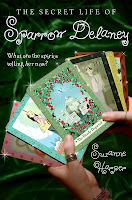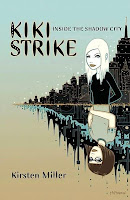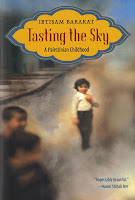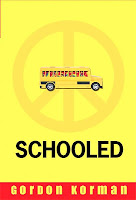
Rules by Cynthia Lord, 2006
Overcoming : Disabilities & mental illness (autism, paralysis)
Family relationships
Best friends & friendship
Outstanding Fiction (Schneider Family Book Award, Newberry Honor book)
Rating : Loved
Frustrated with life with David, her autistic younger brother, twelve-year-old Catherine longs for a normal existence. She is very excited to become friends with her new neighbor Kristi, but is embarrassed by the uniqueness of David. Her world is further complicated by a friendship with a young paraplegic named Jason that she meets at the clinic where David attends sessions.
Having grown up in a home with a younger brother who has Downs Syndrome, Catherine’s story really resonated with me. I loved her humor. I could identify with her insecurities. Though the ending is a bit neat, I loved how she used drawing to see things clearly or more easily, and to communicate with Jason. One of her rules is “Looking closer can make something beautiful.” I loved how she was able to become friends with Jason, and how, when they were one-on-one, she didn’t feel any awkwardness in her interactions with him, only thoughts of improving their communication with each other. I loved how real her insecurities and fears of being labeled weird or strange for having a “weird” disabled friend felt.

Reaching for Sun by Tracie Vaughn Zimmer, 2007
Overcoming : Disabilities & mental illness (cerebral palsy)
Best friends & friendship
Family relationships
Lang arts hook (novel in verse)
Outstanding Fiction (Schneider Family Book Award)
Rating : Liked
Josie, who lies with her mother and grandmother and has cerebral palsy, befriends a boy named Jordan who moves into one of the rich houses behind her old farmhouse. Her left side is “connected by an invisible rubber band” and she “wrestle[s] to wrap [her] lips around syllables, struggle[s] with [her] tongue to press the right points.” The family farmed the land for generations, until grandma needed to sell all but five acres to pay medical bills and Josie’s mom’s education. The story is divided into four sections, one for each season, starting with winter. In spring, Jordan is chasing a butterfly, referring to it by its scientific name, when he comes upon Josie under a willow tree. She knows where it’s gone – the butterfly bush, and can name that plant and many others by scientific names too. In summer, she skips her summer occupational therapy sessions that her mom signed her up for, to hang out with Jordan, enjoying a friendship she never had before. When Gran ends up in the hospital, she blurts out her deception to her mom. “You didn’t bother to ask me. I didn’t bother to tell you.”
This story deserves to be read slowly and savored. The images are rich and feelings provoked by the poetry are real. However, I was impatient in my reading of it, and only got some of the enjoyment available there. Definitely could be read again.

Carpe Diem by Autumn Cornwell, 2007
Adventure & espionage
Family relationships
Character development (life skills)
World cultures & geography (southeast Asia)
Lang Arts hook (creative writing)
Rating : OK
Sixteen-year-old Vassar Spore’s detailed plans for the next twenty years of her life are derailed when her bohemian grandmother insists that she join her in Southeast Asia for the summer, but as she writes a novel about her experiences, Vassar discovers new possibilities. The gist of the story is : over-achieving, inflexible girl learns to put up with dirt and shows even unexpected courage when her situation becomes dangerous.
I was immediately attracted to the title and cover, but the voice caught me by surprise. It was very chatty, high-school-ish and I had to skip ahead to actually get through it. The secret of what made her life-coach mom and efficiency expert dad agree to the trip in the first place was intriguing, and its revelation toward the end probably would have had more impact if I’d read the whole story up till then.

Looks by Madeleine George, 2008
Overcoming (body image & eating disorders)
Best friends & friendship
School story
Rating : Liked
Despite Meghan Ball’s massive size, she’s the most unseen person at Valley Regional High. She can hang out in a niche in the hallway, and other students say things in front of her as though she doesn’t exist, unless she’s being harassed by J-Bar who is cruel about her size and sexually suggestive. She spends most of her days in the sick room. But then one day she shares the sick room with Aimee Zorn, a girl as thin as she is fat. Sprinkled among the plot were introspective observations about the ceiling or sky. We hear about binging from Meghan and self-starvation from Aimee. There are funny cameos from various teachers and office staff throughout.
The plot’s a bit predictable with the two girls getting revenge on the sneaky, two-faced Cara, but I mostly enjoyed the read.

Rebel Angels by Libba Bray, 2005
Fantasy-Historical-19th century Britain
Rating : Liked
Gemma and her friends from the Spence Academy return to the realms to defeat her foe, Circe, and to bind the magic that has been released. It is unclear where the loyalties of Kartik and the brotherhood of the Rakshana lie until the end, as well as that of the new teacher at Spence, the dismissed teacher Ms. Moore, the spectral girls in white, the Gorgon ship. While Gemma gains the attentions of a nobleman’s son, attends balls and the opera, receives gifts, she is hiding the role she has in the Realms.
I read this because I had read the first book this past summer and liked it. The story is set around Christmas, so my timing was good. I liked this one too. I like the characters and how they struggle against the suppression of their time, but I liked the romance and the novelty of the first story better.

Saga (Epic sequel) by Kostick, 2008
Science Fiction
Government & Politics
Rating : Loved
On Saga, a world based on a video role-playing game, fifteen-year-old Ghost lives to break rules, but the Dark Queen who controls Saga plans to enslave its people and those of New Earth, and Ghost and her airboarding friends, along with Erik and his friends from Epic, try to stop her. Erik comes into this new virtual world wielding his magic and blasting away until he comes to the realization that these beings are sentient. He then befriends them and works to dethrone the Dark Queen without any more murder. Ghost and her friends realize that the Dark Queen will not ever stop her quest for domination and is able to find a new way to rule Saga.
I love how the virtual world and corporal world are put on equal footing. I love how the virtual world evolved to include sentient beings. I love how this story included the characters for Epic, but that it was a totally new story.

The True Meaning of Smekday by Adam Rex, 2007
Gratuity is writing an assignment for possible inclusion in a time capsule about the Smekday Holiday and how it has changed in the year since the aliens have left. Her first attempt talks about Moving Day and how she and her pet cat Pig try to drive to Florida instead of taking a ride in the Boov ship, but she runs out of road and must trust a Boov to fix her car. When her teacher asks her to try again, she writes a part two subtitled “How I Learned to Stop Worrying and Love the Boov.” This one begins earlier, before the Boov invasion, and tells how she loses her mom, how the Boov order everyone to move to Florida because of the “hostileness and intolerableness of you people” after five months of occupation, through the time of the previous essay, up until the invasion of the Gorg. After finishing that essay and having it accepted for the time capsule, Gratuity writes Part 3: Attach of the Clones. She tells about her trip from Florida to Arizona, escaping the Gorg, dodging the Boov, finding her mom, and using the Gorg technology against them by cloning Pig and sending the clones out everywhere until the severely allergic Gorg withdraw from Earth.
The interaction between Tip and the J.Lo is clever, like when they try to play car games, or when J.Lo tries to explain about the Boov genders: boy, girl, boygirl, girlboy, boyboy, boyboygirl, and boyboyboyboy. The development of trust, friendship, and eventually familiar love between them is believable and enjoyable to read. The story is illustrated with “snapshots” taken by Tip, comic sequences, drawings, and newspaper clippings. The similarities between the alien invasion and our treatment of Native Americans would be a good talking point for middle schoolers. That Tip is only eleven is the hardest point of the plot to swallow.

Wicked Lovely by Melissa Marr, 2007
The faery Summer King, Keenan, needs a Summer Queen, but the Winter Queen, his mom, made some sort of evil deal and now all his hopefuls turn into either the next Winter Girl with frost so deep in her bones she never warms up or summer fey with nothing but dancing on their minds. Though the faeries are normally invisible to mortals, Aislinn has always seen them. She knows they are powerful and dangerous, and when Keenan sets his sights on her, everything is suddenly on the line: her freedom; her best friend, Seth; her mortality. Contains about half a dozen swear words, one f-. Also, the characters are tattooed and pierced; the characters talk about sex, virginity, and chemical dependence; and there are one or two intimate scenes without being too explicit about any of it. I love the resolution Aislinn comes up with – how she accepts her fate without giving up her aspirations and dreams.





